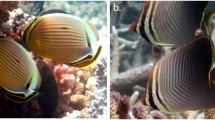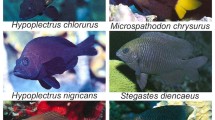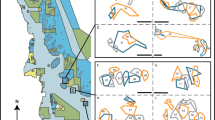Abstract
Butterflyfishes have been well studied for their feeding ecology and mating systems. In particular, studies of corallivorous butterflyfishes have supported models of monogamy based on their predictable, low quality food; a patch of coral that is economically defensible by a pair. Moreover, pairs often exhibit trade-offs in territorial defense (greater by males) and feeding (greater by females) that improve their reproductive success. However, this model has not been well tested for more generalist feeders. In addition, recent hypotheses for monogamy in fish have emphasized parental care, but butterflyfishes do not provide parental care. This study tests five hypotheses for monogamy in the endemic Tahitian butterflyfish, Chaetodon trichrous: 1) uniform distribution of limiting resources, 2) joint defense of a territory, 3) low mate availability, 4) predator detection, and 5) benefits of cooperative behavior. Chaetodon trichrous was the most abundant butterflyfish in bays. Pairs jointly patrolled feeding territories. They preferentially fed over hard substrate other than live coral, however, this substrate was available outside of territories. They also ate plankton. Pairs were sorted positively for size, and all pairs were heterosexual. Males were larger than their partners, but females fed at higher rates. These results suggest that C. trichrous is monogamous, but reject the hypotheses that pairs form for joint defense of a territory (pairs swam together), that pairs remain together because of low mate availability (frequent interactions with neighbors), or that pairs form for predator detection (no homosexual pairs). Monogamy in C. trichrous is associated with the uniform distribution of hard substrate, although this resource is not limiting. Further, the higher feeding rate of females may represent a benefit provided by their monogamous mates.




Similar content being viewed by others
References
Allen GR (1979) Butterfly and angelfishes of the world, vol 2. Wiley, New York, 352
Bagenal TB (1967) A short review of fish fecundity. In: Gerking SD (ed) The biological basis of freshwater fish production. Blackwell Scientific Pubs, Oxford, pp 89–111
Barlow GW (1984) Patterns of monogamy among teleost fishes. Arch Fisch Wiss 35:75–123
Barlow GW (1986) A comparison of monogamy among freshwater and coral-reef fishes. In: Uyeno T, Arai R, Taniuchi T, Matsuura K (eds) Second International Conference on Indo-Pacific Fishes. Ichthyological Society of Japan, Tokyo, pp 767–775
Berumen ML (2005) The importance of juveniles in modelling growth: butterflyfish at Lizard Island. EnvIron Biol Fish 72:409–413
Berumen ML, Pratchett MS (2006a) Effects of resource availability on the competitive behaviour of butterflyfishes (Chaetodontidae). Proc. 10th Int. Coral Reef Symp, pp 644–650
Berumen ML, Pratchett MS (2006b) Recovery without resilience: persistent disturbance and long-term shifts in the structure of fish and coral communities at Tiahura Reef, Moorea. Coral Reefs 25:647–653
Blum SD (1989) Biogeography of the Chaetodontidae: an analysis of allopatry among closely related species. Environ Biol Fish 25:9–31
Bouchon-Navaro Y (1981) Quantitative distribution of the Chaetodontidae on a reef in Moorea Island (French Polynesia). J Exp Mar Biol Ecol 55:145–157
Burgess WE (1978) Butterflyfishes of the world. T.F.H. Publications, Inc. Ltd., New Jersey, p 832
Ehrlich PR, Talbot FH, Russell BC, Anderson GRV (1977) The behavior of chaetodontid fishes with special reference to Lorenz’s poster coloration hypothesis. J Zool Lond 183:213–228
Emlen ST, Oring LW (1977) Ecology, sexual selection, and the evolution of mating systems. Science 197(4300):215–223
Findley JS, Findley MT (1989) Circumtropical patterns on butterflyfish communities. Environ Biol Fish 25:33–46
Gagliardi-Seeley J, Itzkowitz M (2009) Does being paired give male and female convict cichlids (Amatitlania nigrofasciata) an advantage when competing against same-sex individuals? Acta Ethol 12(2):115–120
Galzin R, Pointier JP (1985) Moorea Island, Society Archipelago. Proc 5th Int. Coral Reef Symp. 1, pp 73–102
Gochfeld DJ (2004) Predation-induced morphological and behavioral defenses in a hard coral: implications for foraging behavior of coral-feeding butterflyfishes. Mar Ecol Prog Ser 267:145–158
Gregson MA, Pratchett MS, Berumen ML, Goodman BA (2008) Relationships between butterflyfish (Chaetodontidae) feeding rates and coral consumption on the Great Barrier Reef. Coral Reefs 27:583–591
Gronell AM (1984) Courtship, spawning and social organization of the pipefish, Corythoichthys intestinalis (Pisces: Syngnathidae) with notes on two congeneric species. Z Tierpsychol 65(1):1–24
Harmelin-Vivien ML, Bouchon-Navaro Y (1983) Feeding diets and significance of coral feeding among chaetodontid fishes in Moorea (French Polynesia). Coral Reefs 2(2):119–127
Harris M (2007) Surface zooplankton abundance and diversity, and the salinity tolerances of the subclass Copepoda and crustacean nauplii in Mo’orea, French Polynesia. UC Berkeley: UCB Moorea Class: Biol. and Geomorph. of Trop. Islands. http://escholarship.org/uc/item/15d994df
Helfman G (1983) Underwater methods. In: Neilson LA, Johnson DL (eds) Fisheries techniques. American Fisheries Society, Bethesda, pp 349–370
Hernaman V, Munday PL (2007) Evolution of mating systems in coral reef gobies and constraints in mating system plasticity. Coral Reefs 26(3):585–595
Herold D, Clark E (1993) Monogamy, spawning and skin-shedding of the sea moth, Eurypegasus draconis (Pisces: Pegasidae). Environ Biol Fish 37:219–236
Hobson ES (1974) Feeding relationships of teleostean fishes on coral reefs in Kona. Hawaii Fish Bull 72:915–1031
Hourigan TF (1987) The behavioral ecology of three species of butterflyfishes, Ph.D. Dissertation, University of Hawaii, Honolulu, pp 496
Hourigan TF (1989) Environmental determinants of butterflyfish social systems. Environ Biol Fish 25:61–78
Hsu K, Chen J, Shao K (2007) Molecular phylogeny of Chaetodonidae ( Teleostei:Chaetodontidae) in the Indo-West Pacific: evolution in geminate species pairs and species groups. Raff Bull Zool 14:77–86
Kelley CD, Hourigan TA (1983) The function of conspicuous coloration in chaetodontid fishes: a new hypothesis. Anim Behav 31:615–617
Pratchett MS (2005) Dietary overlap among coral-feeding butterflyfishes (Chaetodontidae) at Lizard Island, northern Great Barrier Reef. Mar Biol 148:373–382
Pratchett MS, Pradjakusuma OA, Jones GP (2006) Is there a reproductive basis to solitary living versus pair-formation in coral reef fishes? Coral Reefs 25:85–92
Randall J (2005) Reef and shore fishes of the South Pacific. University of Hawaii Press, Honolulu, 707
Reavis RH (1997a) The natural history of a monogamous coral-reef fish, Valenciennea strigata (Gobiidae): 1. Abundance, growth, survival and predation. Environ Biol Fish 49:239–246
Reavis RH (1997b) The natural history of a monogamous coral-reef fish, Valenciennea strigata (Gobiidae): 2. Behavior, mate fidelity and reproductive success. Environ Biol Fish 49:247–257
Reavis RH, Barlow GW (1998) Why is the coral-reef fish Valenciennea strigata (Gobiidae) monogamous? Behav Ecol Sociobiol 43:229–237
Reavis RH, Barrett M (2001) Do parasites affect the behavior of the Hawaiian white-spotted toby, Canthigaster jactator (Pisces). Acta Ethol 3:151–154
Reese ES (1975) A comparative field study of the social behavior and related ecology of reef fishes of the family Chaetodontidae. Z Tierpsychol 37:37–61
Roberts CM, Ormond RFG (1992) Butterflyfish social behavior, with special reference to the incidence of territoriality: a review. Environ Biol Fish 34:79–93
Robertson DR, Polunin NVC, Leighton K (1979) The behavioral ecology of three Indian Ocean surgeonfishes (Acanthurus lineatus, A. leucosternon and Zebrasoma scopas): their feeding strategies and social and mating systems. Environ Biol Fish 4:125–170
Tricas TC (1989) Prey selection by coral-feeding butterflyfishes: strategies to maximize profit. Environ Biol Fish 25:171–185
Vincent ACJ (1994) Operational sex ratios in seahorses. Behaviour 128:153–167
Whiteman EA, Cote IM (2004a) Monogamy in marine fishes. Bio Rev 79:351–375
Whiteman EA, Cote IM (2004b) Social monogamy in the Caribbean cleaning goby Elactinus evelynae: Ecological constraints or net benefit? Anim Behav 66(2):281–291
Yabuta S (2007) Social groupings in 18 species of butterflyfish and pair bond weakening during the nonreproductive season. Ichthyol Res 54:2207–2210
Acknowledgements
We are indebted to the students of Glendale Community College’s Coral Reef Ecology and Scientific Diving classes of 2006 and 2007 for their hours of surveys and observations: David and Elizabeth Hoffman, Nicole Kist, Rebecca Lucero, Sarah McDarby, Russell Smith, Robbert Vermeulen, Marie Utterback and Robynn Utterback. Thanks to all at Le Centre De L'Environnement De Moorea (CRIOBE-EPHE), French Polynesia for their support and hospitality. Thanks to George Barlow for his early support and inspiration for this project. We would also like to thank Alice Gibb, Stephen Shuster, Heather Bleakley, Kenyon Mobley, Cinnamon Pace, Mathew O’Neil, Cassie Kaapu-Lyons, Morgan Burnette and three anonymous reviewers for their critical comments. This research was funded in part by the American Museum of Natural Histories Lerner Grey Fund for Marine Research (JMC), Northern Arizona Universities Hooper Undergraduate Research Award (JMC), Northern Arizona University IGERT-UG (JMC), the Sigma Xi fund for research (JMC), the American Academy of Underwater Sciences Kevin Gurr Scholarship (JMC), Northern Arizona University Dept. of Biology and College of Engineering and Natural Sciences (JMC), and Maricopa Community College District Professional Growth award (RHR).
Author information
Authors and Affiliations
Corresponding author
Rights and permissions
About this article
Cite this article
Reavis, R.H., Copus, J.M. Monogamy in a feeding generalist, Chaetodon trichrous, the endemic Tahitian Butterflyfish. Environ Biol Fish 92, 167–179 (2011). https://doi.org/10.1007/s10641-011-9826-y
Received:
Accepted:
Published:
Issue Date:
DOI: https://doi.org/10.1007/s10641-011-9826-y




